Secretion Study guides, Class notes & Summaries
Looking for the best study guides, study notes and summaries about Secretion? On this page you'll find 24317 study documents about Secretion.
Popular textbooks 'Secretion'

The Syndrome of Inappropriate Secretion of Antidiuretic Hormone (SIADH)
Frederic C. Bartter
1 documents
All 24.317 results
Sort by
 Popular
Popular
-
NR 507 MIDTERM EXAM WEEK 4 – QUESTION AND ANSWERS (Verified Answers) Download To Score A
- Exam (elaborations) • 11 pages • 2023
-
- $13.99
- 66x sold
- + learn more
NR 507 MIDTERM EXAM WEEK 4 – QUESTION AND ANSWERS WINTER 2023 Chamberlain University NR 507 MIDTERM EXAM WEEK 4 – QUESTION AND ANSWERS WINTER 2023 Chamberlain University 1. Hypertension (high blood pressure) will have its most immediate effect on Preload Contractility Afterload None of these 2. Mature, circulating RBC’s lack endoplasmic reticulum. Without these structures RBC’s are completely unable to synthesize any ATP Pr...
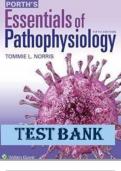
-
Porth’s Essentials Of Pathophysiology 5th Edition Test Bank with Rationales | Complete Guide A+
- Exam (elaborations) • 600 pages • 2023 Popular
-
- $24.99
- 21x sold
- + learn more
Porth’s Essentials Of Pathophysiology 5th Edition Test Bank 1. Chapter 1 Although the basic structure of the cell plasma membrane is formed by a lipid bilayer, most of the specific membrane functions are carried out by: A) Bound and transmembrane proteins B) Complex, long carbohydrate chains C) Surface antigens and hormone receptors D) A gating system of selective ion channels Ans: A Feedback: The functions of plasma membrane depend on the presence of proteins that are bound in the lipid bilay...

-
Exam 3: NSG530/ NSG 530 (Latest 2023/ 2024) - Advanced Pathophysiology Exam Review| Guide with Questions and Verified Answers| 100% Correct
- Exam (elaborations) • 47 pages • 2023
-
Available in package deal
-
- $10.99
- 5x sold
- + learn more
Exam 3: NSG530/ NSG 530 (Latest 2023/ 2024) - Advanced Pathophysiology Exam Review| Guide with Questions and Verified Answers| 100% Correct Q: the stomach is impermeable to what? Answer: water, but can absorb alcohol and aspirin as they are lipid soluble. Q: blood to stomach is supplied by ? Answer: celiac artery- abundant! Q: Three phases of gastric secretion Answer: lic phase ic phase tinal phase Q: Motilin Answer: increases peristalsis Q...
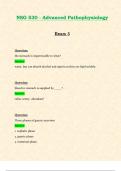
-
NSG530 / NSG 530 Exam 3 (Latest 2024 / 2025): Advanced Pathophysiology | Review Guide with Questions and Verified Answers | 100% Correct - Wilkes
- Exam (elaborations) • 99 pages • 2024
- Available in package deal
-
- $7.99
- 3x sold
- + learn more
Exam 3: NSG530 / NSG 530 (Latest 2024 / 2025) - Advanced Pathophysiology Exam Review | Guide with Questions and Verified Answers | 100% Correct - Wilkes Q: the stomach is impermeable to what? Answer: water, but can absorb alcohol and aspirin as they are lipid soluble. Q: blood to stomach is supplied by ? Answer: celiac artery- abundant! Q: Three phases of gastric secretion Answer: lic phase ic phase tinal phase Q: Motilin Answer: increases peristalsis Q: Secretin Answer: decreases peristalsis Q:...
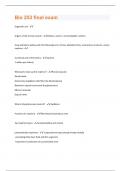
-
Bio 253 final Exam 195 Questions With Complete Solutions.
- Exam (elaborations) • 19 pages • 2023
- Available in package deal
-
- $8.49
- 9x sold
- + learn more
Organelles are - Organs of the Urinary system - kidneys, ureters, urinary bladder, urethra draw and label a kidney with the following terms: Cortex, Medulla, Pelvis, renal artery, renal vein, ureter, nephron - functional unit of the kidney - nephron 1 million per kidney! What parts make up the nephron? - Renal corpuscle Renal tubule Glomerulus (capillaries that filter the blood plasma) Bowman's capsule (surrounds the glomerulus) Efferent arteriole loop of henle What is the glomeru...

-
BIOD 101 Module 5 Exam Portage learning
- Exam (elaborations) • 15 pages • 2023
-
Available in package deal
-
- $17.49
- 8x sold
- + learn more
Question 1 4 / 4 pts Multiple Choice: Which of the following signaling types occurs during periods of development specifically for the secretion of growth factors? Autocrine signaling Endocrine signaling Direct cell-to-cell signaling Correct! Paracrine signaling Synaptic signaling Question 2 4 / 4 pts Explain why a steroid hormone would require a carrier protein to transport it through the bloodstream. Answer: Steroid hormones are hydrophobic. They would require a carrier pr...
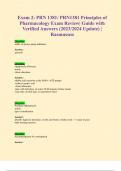
-
Exam 2: PRN 1381/ PRN1381 Principles of Pharmacology Exam Review| Guide with Verified Answers (2023/2024 Update) | Rasmussen
- Exam (elaborations) • 26 pages • 2023
-
Available in package deal
-
- $11.99
- 2x sold
- + learn more
Exam 2: PRN 1381/ PRN1381 Principles of Pharmacology Exam Review| Guide with Verified Answers (2023/2024 Update) | Rasmussen Question: suffix of proton pump inhibitors Answer: -prazole Question: omeprazole (Prilosec) action client education Answer: inhibit acid secretion at the H+K+ (ATP pump) -reduces gastric acid client education: -take with full glass of water 30-60 minutes before meals -may take several days to experience relief Question: Psyllium (Metamuci...
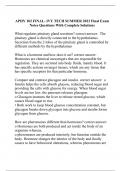
-
APHY 102 FINAL- IVY TECH SUMMER 2023 Final Exam Notes Questions With Complete Solutions
- Exam (elaborations) • 43 pages • 2023
-
Available in package deal
-
- $15.99
- 2x sold
- + learn more
What regulates pituitary gland secretion? correct answer: The pituitary gland is directly connected to the hypothalamus. Secretion from the 2 lobes of the pituitary gland is controlled by different methods by the hypothalamus What is a hormone and how does it act? correct answer: Hormones are chemical messengers that are responsible for regulation. They are secreted into body fluids, mainly blood. It has specific actions on target tissues, which are any tissue that has specific receptors fo...
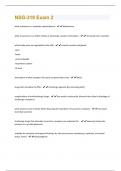
-
NSG-318 Exam 2 Questions and Answers Solved Correctly
- Exam (elaborations) • 28 pages • 2023
- Available in package deal
-
- $12.29
- 2x sold
- + learn more
what substance is a synthetic catecholamine - dobutamine what occurrence is an effect of beta-1 adrenergic receptor stimulation - increased renin secretion which body parts are regulated by the ANS - smooth muscles and glands -eyes -heart -urinary bladder -respiratory system -GI tract stimulation of what receptor will cause increased heart rate - Beta 1 drugs that stimulate the PNS - cholinergic agonists (by mimicking ACH) complications of anticholinergic drugs - dry mouth, tachycardia...
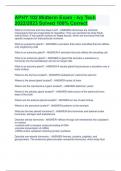
-
APHY 102 Midterm Exam - Ivy Tech 2022/2023 Solved 100% Correct
- Exam (elaborations) • 14 pages • 2023
- Available in package deal
-
- $11.99
- 2x sold
- + learn more
What is a hormone and how does it act? - ANSWER-Hormones are chemical messengers that are responsible for regulation. They are secreted into body fluids, mainly blood. It has specific actions on target tissues, which are any tissue that has specific receptors for that particular hormone. What is a paracrine gland? - ANSWER-a secretion that enters interstitial fluid but affects only neighboring cells What is an autocrine gland? - ANSWER-A secretion that only affects the secreting cell. W...
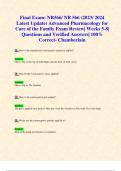
-
Final Exam: NR566/ NR 566 (2023/ 2024 Latest Update) Advanced Pharmacology for Care of the Family Exam Review| Weeks 5-8| Questions and Verified Answers| 100% Correct- Chamberlain
- Exam (elaborations) • 25 pages • 2023
-
Available in package deal
-
- $11.99
- 2x sold
- + learn more
Final Exam: NR566/ NR 566 (2023/ 2024 Latest Update) Advanced Pharmacology for Care of the Family Exam Review| Weeks 5-8| Questions and Verified Answers| 100% Correct- Chamberlain Q: How is the transdermal contraceptive emulsion applied? Answer: Once a day to the top of both thighs and the back of both calves Q: How IS the Contraceptive spray applied? Answer: Once a day to The forearm Q: How is the contraceptive gel applied? Answer: The gel is applied once da...

Do you wonder why so many students wear nice clothes, have money to spare and enjoy tons of free time? Well, they sell on Stuvia! Imagine your study notes being downloaded a dozen times for $15 each. Every. Single. Day. Discover all about earning on Stuvia


